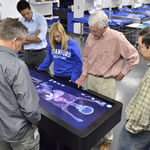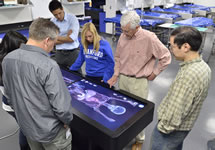
If Meghan Bowler needs to take a closer look at the cadaver in front of her, she just slides her finger across to slice it open.
The cadaver is actually a three-dimensional anatomical model on a virtual dissection table, that Bowler and her Stanford classmates were the first to test this spring quarter.
“While it’s not the real thing, it’s about as close as you can get,” she said.
The table features life-size models of the human body that can be manipulated using a touch-screen interface.
Students can zoom in on or rotate different structures, and remove individual organs. The table also can use real data from MRI and CT scans of patients.
“You can see really specifically how certain organs connect, which can be really hard to see in a cadaver,” Bowler said. “It’s very intuitive.”
The table was built by San Jose-based Anatomage, which loaned the system to Stanford to test in an undergraduate anatomy course for bioengineers.
“When I first saw it, my reaction was a simple ‘wow!’ ” said Sakti Srivastava, the chief of the division of clinical anatomy at the Stanford University School of Medicine, who teaches the course. “I’ve been imagining it for a long time.”
Srivastava has been evaluating the effectiveness of the table as a teaching tool. “It’s not a replacement for a cadaver, but it’s a nice complement,” he said.
Srivastava will continue to use the table during courses he’s teaching over the summer and hopes to introduce it into the medical students’ curriculum in the fall.
Paul Brown, consulting associate professor in the division of anatomy at Stanford, said he got the idea of developing a library of various anatomical images to use in such a table because medical students generally work on just one cadaver.
“A 300 pound football player is different from a 100 pound Japanese woman,” he said. “I was interested in providing a larger number of cadavers — men, women, size variations, different ethnicities.”
Students eventually will be able to download the data onto computers and tablets so they can review it at home, since “you can’t take a cadaver home in your briefcase,” Brown said.
Brown said he described the idea for the virtual dissection table to his friend Jack Choi, CEO and president of Anatomage. What Choi produced “was far superior to what we expected, and with even more potential in the future,” Brown said.
Apart from schools and universities, Choi envisions the table being used in a clinical setting for doctors to conduct discussions either among themselves or with patients.
“When we first released it in one radiology meeting, doctors were very positive and said this was the coolest product they have seen,” Choi said.
Choi plans to develop a version of the table that could simulate real treatment procedures, so that doctors can use it for training.
Srivastava is working with engineers to develop feedback devices for the table that would allow users to actually touch and feel the virtual bodies.
Surgeons could rehearse an operation on a virtual representation of a patient, he said, and in the future “we could actually simulate open surgery, which hasn’t happened before.”
Copyright (c) 2011, San Jose Mercury News. Visit MercuryNews.com, the website of the Mercury News, at http://www.mercurynews.com. Distributed by McClatchy-Tribune Information Services.
- Extron AV Switching, Streaming, and Control Systems Aid Higher Learning at Idaho’s First Medical School - June 1, 2021
- Extron XTP, Streaming, and Control Systems Empower Point Park University’s Varsity Esports Program - June 1, 2021
- Extron NAV Series Delivers AVoIP Throughout Allied Health Veterans Hall at UNC Wilmington - June 1, 2021

